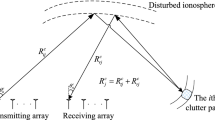Abstract
The eigenanalysis canceler (EC) method which is suitable for nonhomogeneous clutter can suppress clutter effectively by discarding the eigenvectors of small eigenvalues, which is a well-known subspace-based space-time adaptive processing (STAP) method. However, the computational complexity of conventional EC STAP method is huge due to the eigenvalue decomposition. Moreover, the corresponding performance would be degraded significantly by the subspace leakage phenomenon, since the clutter subspace is not strictly confined to a low-rank subspace any more. Therefore, an improved EC STAP method based on the data-independent clutter subspace estimation is proposed to reduce the computational complexity, where the clutter subspace is rapidly constructed by sampling the prolate spheroidal wave functions (PSWF) non-uniformly. In order to deal with the subspace leakage phenomenon, the proposed EC-PSWF STAP method is modified based on the covariance matrix taper (CMT) to obtain the covariance matrix by re-establishing the noise floor. The corresponding performance of proposed method is evaluated by using the numerical simulation.
Similar content being viewed by others
References
Ward J. Space-time adaptive processing for airborne radar. Technical Report 1015, Lincoln Laboratory, MIT. 1994
Guerci J R. Space-Time Adaptive Processing for Radar. Artech House, 2003
Yang X P, Liu Y X, Long T. Pulse-order recursive method for inverse covariance matrix compution applied to spacetime adaptive processing. Sci China Inf Sci, 2013, 56: 042312
Wu R B, Jia Q Q, Li H. A novel STAP method for the detection of fast air moving target from high speed platform. Sci China Inf Sci, 2012, 55: 1259–1269
Gong W F, Sun X. An improved reduced-rand STAP interference suppression method in design of GNSS receivers. Sci China Inf Sci, 2012, 55: 2329–2342
Reed I S, Mallett J D, Brennan L E. Rapid convergence rate in adaptive arrays. IEEE Trans Aerosp Electron Syst, 1974, 10: 853–863
Fa R, de Lamare R C. Reduced-rank STAP algorithms using joint iterative optimization of filters. IEEE Trans Aerosp Electron Syst, 2011, 47: 1668–1684
Gierull C H, Balaji B. Minimal sample support space-time adaptive processing with fast subspace techniques. IEE Proc-Radar Sonar Navig, 2002, 149: 209–220
Haimovich A, Bar-Ness Y. An eigenanalysis interference canceler. IEEE Trans Signal Process, 1991, 39: 76–84
Haimovich A. The eigencanceler: adaptive radar by eigenanalysis methods. IEEE Trans Aerosp Electron Syst, 1996, 32: 532–542
Goldstein J S, Reed I S. Reduced rank adaptive filtering. IEEE Trans Signal Process, 1997, 45: 492–496
Goldstein J S, Reed I S, Zulch P A. Multistage partially adaptive STAP CFAR detection algorithm. IEEE Trans Aerosp Electron Syst, 1999, 35: 645–661
Guerci J R, Goldstein J R, Reed I S. Optimal and adaptive reduced-rank STAP. IEEE Trans Aerosp Electron Syst, 2000, 36: 647–663
Chen C Y, Vaidyanathan P P. MIMO radar space-time adaptive processing using prolate spheroidal wave function. IEEE Trans Signal Process, 2008, 56: 623–635
Yang X P, Liu Y X, Hu X N, et al. Robust generalized inner products algorithm using prolate spheroidal wave functions. In: IEEE Radar Conference, Atlanta, 2012. 581–584
Guerci J R, Bergin J S. Principal components, covariance matrix tapers, and the subspace leakage problem. IEEE Trans Aerosp Electron Syst, 2002, 38: 152–162
Guerci J R. Theory and application of covariance matrix tapers for robust adaptive beamforming. IEEE Trans Signal Process, 1999, 47: 977–985
Melvin W L, Showman G A. An approach to knowledge-aided covariance estimation. IEEE Trans Aerosp Electron Syst, 2006, 42: 1021–1042
Carlson B D. Covariance matrix estimation errors and diagonal loading in adaptive arrays. IEEE Trans Aerosp Electron Syst, 1988, 24: 397–401
Author information
Authors and Affiliations
Corresponding author
Rights and permissions
About this article
Cite this article
Long, T., Liu, Y., Yang, X. et al. Improved eigenanalysis canceler based on data-independent clutter subspace estimation for space-time adaptive processing. Sci. China Inf. Sci. 56, 1–10 (2013). https://doi.org/10.1007/s11432-013-5003-6
Received:
Accepted:
Published:
Issue Date:
DOI: https://doi.org/10.1007/s11432-013-5003-6




